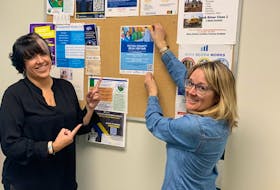It’s often referred to as the 10-per-cent rule.
In other words, how much someone should be setting aside and saving each pay.
Recently, the Canadian Payroll Association released its annual survey that found 71 per cent of employed people in Atlantic Canada saved 10 per cent of their earnings or less, which was the lowest in Canada.
The survey of 5,074 employees in Canada also found 41 per cent of Atlantic Canadians spent all or more of their net pay (compared to 35 per cent nationally).
“If you start doing this early, you never really have to do much more than that.”
“You almost need to create this as the ‘me bill’ and ‘pay myself,’” said George Weatherbie, a Charlottetown-based representative of Credential Financial Strategies, which offers wealth management planning, life insurance and investments to members of Provincial Credit Union.
Weatherbie said one thing that needs to be considered when looking at the so-called 10-per-cent rule is if you can’t afford to set aside that amount each pay, then set aside what you can afford, even if it’s less.
It shouldn’t be looked at as “10 per cent or nothing,” he said. “Starting is the key.”
Even if someone sets aside six per cent, over time and with interest, that adds up. The issue is most people, especially young adults, don’t sit down and visualize what that amount will look like as it accumulates over time. Seeing the end result motivates people to start and continue to save.

“They see the big number,” he said. “Once you start, it’s hard to stop.”
The other thing to remember is that 10 per cent can have a variety of purposes, such as paying down a credit card debt or contributing to an emergency fund. And, as young families pay down debt and get past the struggling stages of life, it becomes easier to set money aside – 10 per cent or more – for retirement.
Finding small savings that add up may not be as hard as it seems.
Weatherbie explained that even cutting out buying one cup of coffee a day can add up to $60 a month, or $720 a year (plus interest), which can grow over time in an account, such as an RRSP or TFSA (Tax Free Savings Account).
Emily Rae, senior financial planning advisor with Assante Capital Management Ltd. in Halifax, said trying to save 10 per cent of your pay is an excellent goal, particularly when you start in your mid-20s.
“If you start doing this early, you never really have to do much more than that. Sometimes people think they can wait until their mid-40s to start saving 10 per cent. The math just doesn’t work with the compounding, and sometimes they have to save more or work longer or do all the other things they need to do to build their retirement nest egg.”
She agreed there are times when people can’t set aside that amount each pay, such as when someone is on maternity leave or paying down a student loan debt.
“And then after that, start saving 10 per cent,” she said.
Rae said people tend to put this saving component to the bottom of their budget after setting money aside for payments and a vacation, when in fact it should be at the top.
“If it’s higher up and always part of your plan, it’s just a habit. Of course you’re going to save money, you always have and always will,” she said.
“The other thing is to start saving. And, once you get in the habit of starting, you can build on it after that.”









